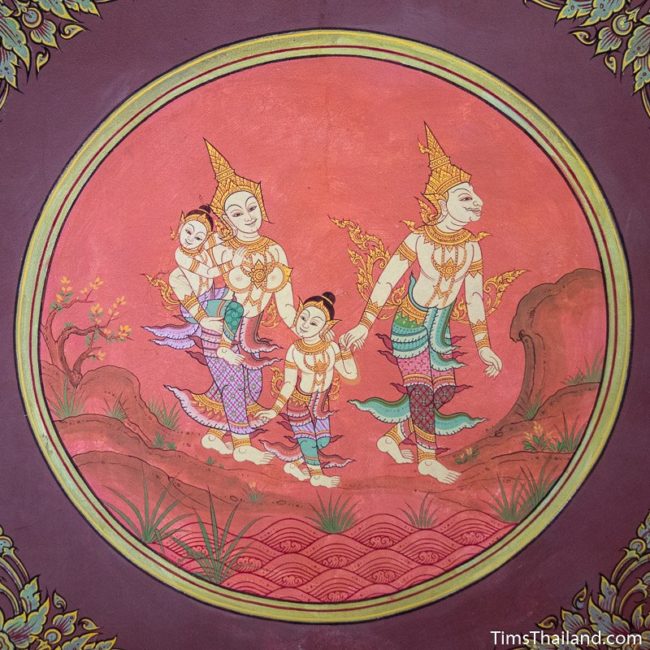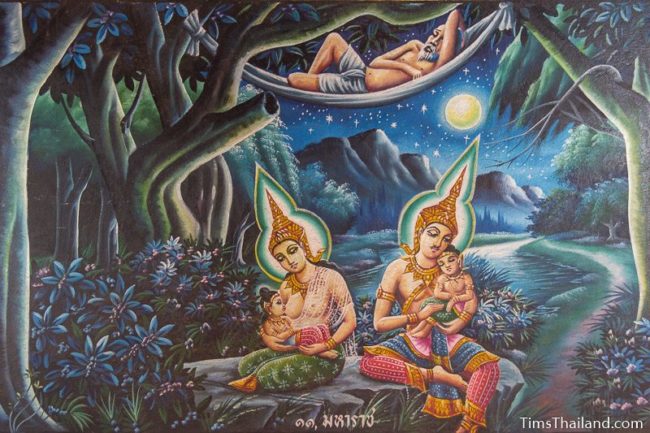The 547 Jataka tales (chah-dok in Thai) recount stories from some of the past lives of the being who would eventually become the Buddha. The final ten stories, called tot-sah-chat chah-dok (ทศชาติชาดก) or phra-jao-sip-chat (พระเจ้าสิบชาติ ) in Thai and the Mahanipata Jataka in English (and often known as “The Ten Great Birth Stories of the Buddha”), are morality tales in which the Bodhisatta (what a Buddha-to-be is called) develops the ten paramitas (“perfections of character”) that one needs to master in order to reach enlightenment. Mural paintings of these ten Jataka are common features in Thai temples. But you need to know the stories to understand these ubiquitous pictures.
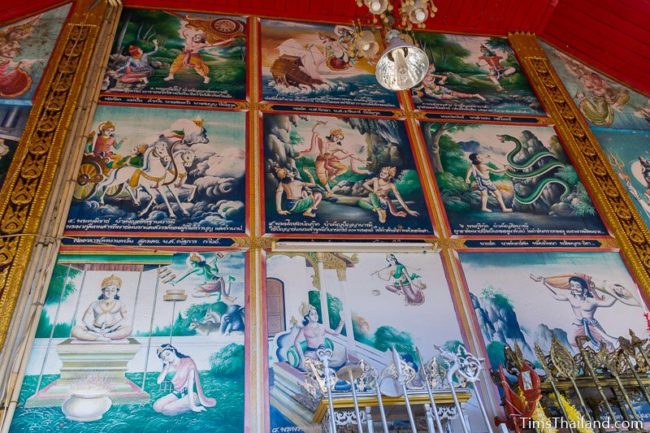
These stories are almost always shown just as single-panel scenes such as those below. The primary pictures (taken at Wat Chetawan, Chiang Mai) used here are the classic representations used in most temples, though as other photos show, occasionally different events are used. The one exception is that for the Vessantara Jataka pictures of both the family walking in the forest and of the decrepit old brahmin sleeping in a hammock while the children are cared for down below by two gods are used just as often as the elephant.
The Vessantara Jataka, the last Jataka and the penultimate earthly life of the Buddha, is by far the most popular and important Jataka – most Thais can tell you the story of Prince Vessantara’s life better than they can the Buddha’s – and it’s pretty much the only Jataka ever painted in long-form (see an example from Khon Kaen’s Wat Nong Wang), often running around the building on three or four walls.
One quirk about the last ten Jataka tales in Thailand is that they have different names and a different sequence than the classic collection used most other places. Here they are shown in the Thai order with the numbers in parenthesis showing the standard sequence. Also note that most of them have multiple Thai names: this is mostly because the names were adapted from Pali, which results in many letters and sounds that can either be spoken or silent. For example, the first Jataka can be pronounced either Tay-Mee or Tay-Mee-Yah.
These versions are just short summaries; the English translations offered by the Pali Text Society run between about 6,000 and 47,000 words. I’ve also written longer, but still abridged versions and some background about the Jataka tales. The full stories are available online, though the versions in The Ten Great Birth Stories of the Buddha: The Mahanipata of the Jatakatthavanonoana (Silkworm Books, 2016) by Naomi Appleton and Sarah Shaw are superior translations in contemporary English and are immensely more enjoyable.
1 – Temi Chadok (เตมียชาดก)
- Standard name: Muga-Pakkha Jataka (#1)
- Perfection of character: renunciation (nekkhamma)
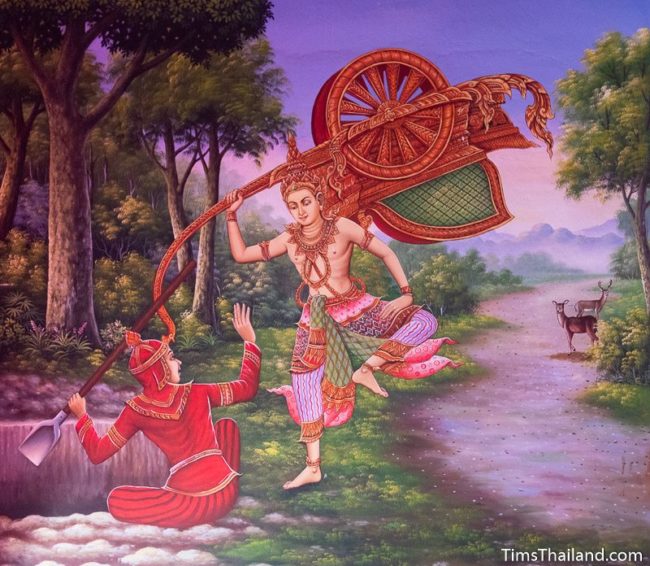
The Bodhisatta was once a crown prince named Temiya. Despite King Kasi having sixteen-thousand wives, the Bodhisatta was his only child. So when he was born healthy and with auspicious marks, the king gave his chief queen, Candadevi, a wish for anything she wanted. She chose to keep it for future use. When the Bodhisatta was one month old he saw his father sentence four thieves to torture and death. His father’s cruelty scared him and prompted him to remember that in a recent past life he had gone to hell after being a king. To avoid suffering this fate again, he did not want to become king after his father. A goddess who lived in the umbrella that shaded him sensed his worry and told him that if he acted disabled, deaf, and mute he would not be crowned king. The Bodhisatta took her advice and from then on lay completely unresponsive at all times.
For sixteen years the king and queen tried to break the Bodhisatta of this behavior by withholding food, offering cakes, covering him with molasses and letting flies bite him, letting gorgeous women seduce him, placing him over fire until his skin blistered, and other such tricks and tortures. And all this time not once did the Bodhisatta break because the torments of hell are far worse and last far longer.
When the Bodhisatta came of age, King Kasi’s seers warned that if he wasn’t killed, catastrophe would befall the kingdom. Out of fear, the king agreed to do it. A devastated Queen Candadevi tried to use her stockpiled wish to save their son. While the king would not reconsider the execution, he did agree to postpone it for one week. But despite desperate pleas, the queen could not get the Bodhisatta to move or speak.
When the time came, the king had the Bodhisatta driven out to the charnel grounds to be killed and buried. No longer able to be the king since he was banished, the Bodhisatta was finally free. As the charioteer dug a grave, the Bodhisatta stood up and found himself so strong he could lift the chariot as if it were a child’s toy. He revealed himself to his intended executioner, told his story, and ordered the man to bring his parents out to see him. In the meantime, he began a humble religious life as an ascetic. After discussing righteousness with his parents, they and tens of thousands of other people decided to abandon their worldly lives and take religious vows as ascetics under the Bodhisatta’s teachings. They all lived out their days in a giant forest hermitage built and supplied by Indra, king of the gods.
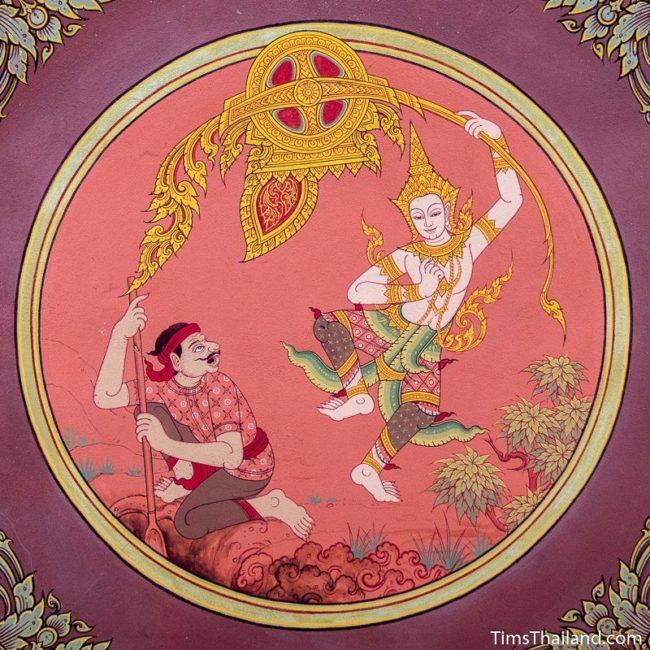
2 – Chanok Chadok (ชนกชาดก)
- Standard name: Mahajanaka Jataka (#2)
- Perfection of character: endurance (viriya)
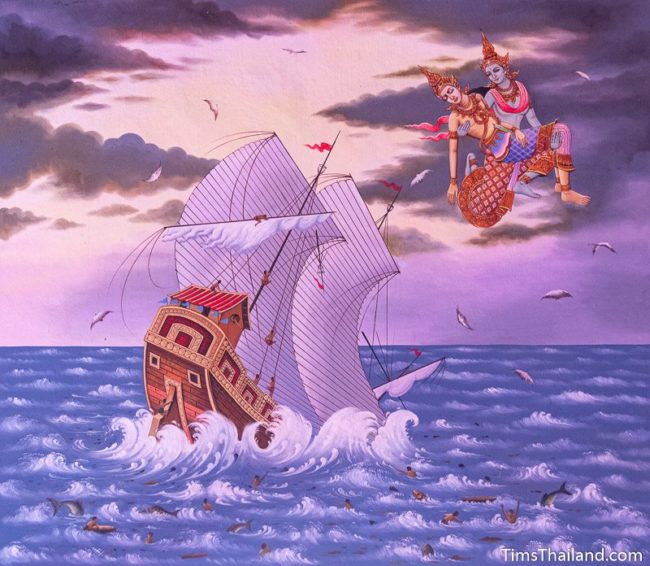
The Bodhisatta was once a widowed queen’s son named Mahajanaka. Her husband, King Aritthajanaka, feared being betrayed by his brother, Prince Polajanaka, so he had him arrested. Polajanaka was so thoroughly righteous the gods helped him escape his prison cell and leave the city. Though Polajanaka had absolutely no ill intent toward the king before his imprisonment, afterward he considered him an enemy and soon returned to kill him and take the throne. After the war, Aritthajanaka’s pregnant queen, disguised as a peasant with her gold and jewels hidden in a basket of rice, fled to a distant city where the Bodhisatta was born. When the Bodhisatta came of age, he went off to reclaim his father’s throne, using half of his mother’s treasure to fund the venture.
The Bodhisatta boarded a ship sailing to Suvarnabhumi, the golden land of the east. After seven days at sea, the ship sank. As it went down, he ate a big meal, covered his body with sugar and ghee, and put on extra clothes covered with oil. The water around the boat turned red from fish and turtles eating the ill-fated passengers, but the Bodhisatta used his special strength to leap far away from the ship and avoid a similar fate. And unbeknownst to him, on the same day, his uncle, the king, died.
The Bodhisatta floated helplessly for a week before the goddess of the ocean rescued him and carried him to a mango grove near his family’s palace. The king had no brothers or sons to inherit the throne, and none of the palace nobles met his daughter’s approval, one of several deathbed conditions the king had laid down for a successor. Since Princess Sivali couldn’t find a new king, the chaplain set the royal chariot loose, a foolproof method to find someone with sufficient merit to be a great king. The horses pulling it stopped at the stone where the Bodhisatta lie sleeping. Though the chaplain did not know who the Bodhisatta was, he saw the signs of royalty on his feet and he was crowed right then and there. He ruled wisely and benevolently, beloved by all, and made Sivali his queen. He brought his mother home and his life was filled with endless joy.
Many year later, the Bodhisatta encountered two mango trees, one full of fruit and the other without. After he ate a mango, people destroyed the fruitful tree in search of more, but left the barren tree unharmed. Seeing this as a metaphor for life – having possessions leads to misery – the Bodhisatta left his glory behind and struck off to the Himalayas to live as an ascetic. A distraught Queen Sivali followed him out of town despite his repeated orders to turn around. They passed a girl sifting sand with two bracelets on one wrist and only one of the other and the Bodhisatta explained that the two bracelets together made an annoying noise but the single bracelet was peaceful. Later he plucked a blade of grass and told her they were like it; they could never be rejoined. Overcome with grief by her husband’s callousness, she passed out and the Bodhisatta was finally able to sneak away. Queen Sivali returned to the city, crowned her son as the next king, and lived the rest of her life as an ascetic in the mango grove.
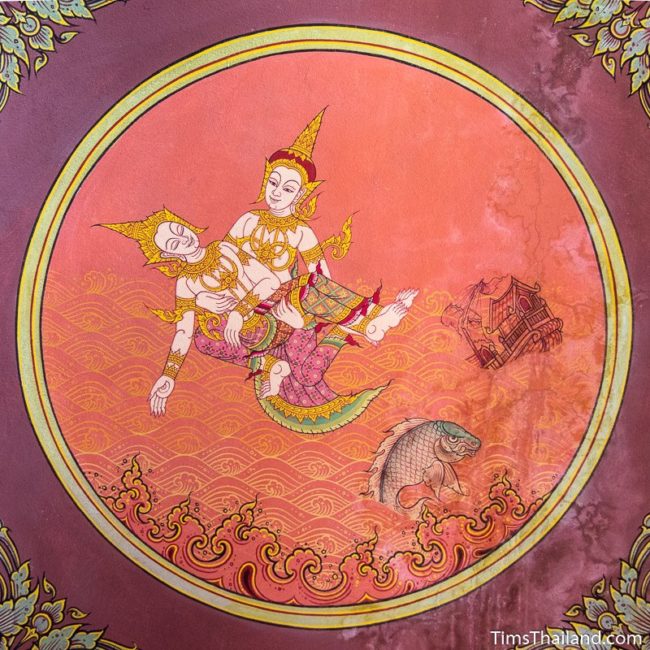
3 – Suwannasam Chadok (สุวรรณสามชาดก)
- Standard name: Sama Jataka (#3)
- Perfection of character: loving kindness (metta)
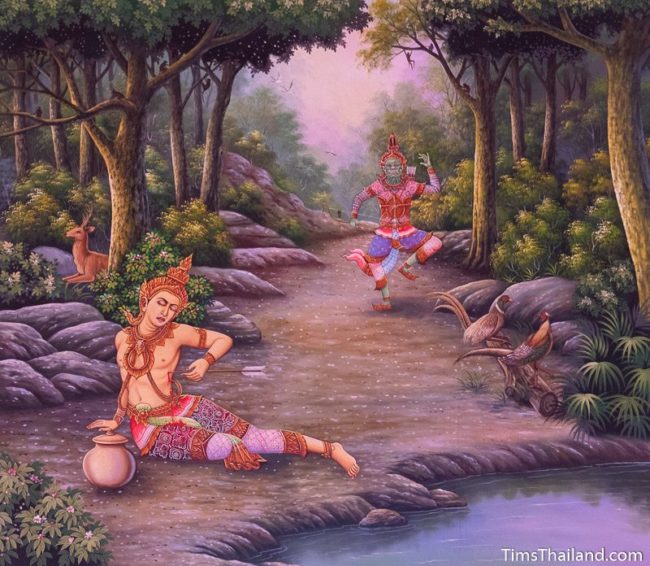
The Bodhisatta, named Sama, was once the son of two ascetics. The chiefs of two hunting villages, long-time friends, wanted two of their children, Dukulaka and Parika, to marry each other when they came of age. Growing up, they were not normal children and lived thoroughly religious lives devoted to righteousness and purity. After their parents put them through a forced marriage, they left the city to live as ascetics deep in the Himalayas. They lived in bliss on fruits and roots gathered in the forest and their virtue was so strong even animals living around them did not harm each other.
Indra, king of the gods, foresaw they would go blind one day, so he urged them to have a child to look after them when the time came. They refused to violate their celibacy, but Indra explained how Dukulaka could impregnate Parika by touching her navel at an auspicious time. And this is how the Bodhisatta was conceived. When he was sixteen, an angry snake spit venom in his parent’s faces, causing the predicted tragedy.
The Bodhisatta cared for them without hesitation, gathering all their food and water with the help of deer carrying what he collected. One day while out hunting, the king was amazed to see the Bodhisatta walking with deer and he desperately wanted to know his story. Assuming the Bodhisatta would flee if he saw him, the king shot the Bodhisatta with a poison arrow to stun him so he could approach and talk. As the Bodhisatta lie dying with blood flowing out of his mouth, the king lied that he had shot him by mistake after a deer had run off. But upon hearing the Bodhisatta’s story the king felt deep remorse and confessed his crime. And as requested just before the Bodhisatta lost consciousness, he promised to take care of the Bodhisatta’s parents.
The king found their forest home and broke the terrible news to his parents. They cried in agony, but forgave the king. At their request he took them to see their son’s body and, finding that he had not yet died, they prayed for the gods to save him if they had made enough merit in previous lives. They had, and not only was the Bodhisatta fully healed, but his parent’s sight was restored. The king returned home and became a righteous, generous ruler.
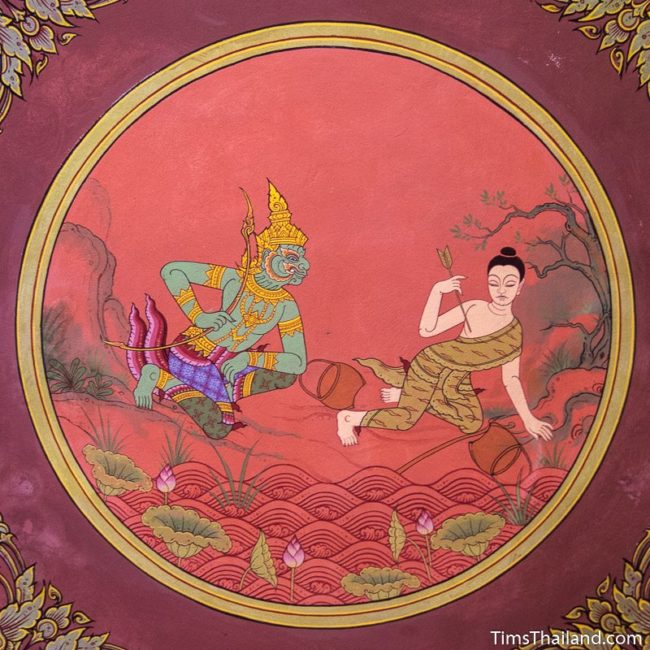
4 – Nemirat Chadok (เนมิราชชาดก)
- Standard name: Nimi Jataka (#4)
- Perfection of character: determination (adhitthana)
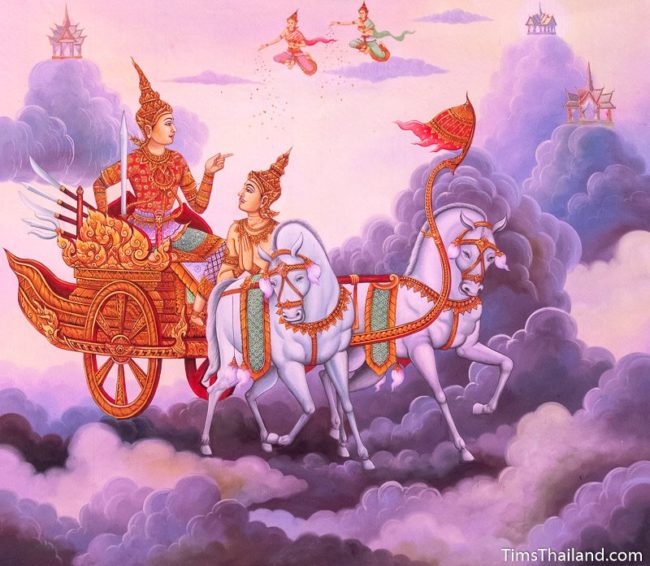
The Bodhisatta was once a king named Nimi. He had previously reigned with wisdom and virtue for eighty-four thousand years as King Makhadeva and on the day his barber found a grey hair he passed the throne to his eldest son and lived out his final eighty-four thousand years as an ascetic before being reborn in heaven. He watched with pride as his son, his grandson, and on and on through a total of eighty-four thousand minus two generations followed this exact same path through life and death, always ruling righteously. But he now knew that he and his family had not quite done enough to be on the path to nirvana, so he decided to return to earth as the present king’s son to finish off the line.
From childhood through his time on the throne, the Bodhisatta was uncompromisingly generous and righteous. So many people absorbed his lessons and were reborn in heaven the gods took notice and sang the Bodhisatta’s praise. Always striving for perfection, the Bodhisatta wondered whether leading a holy life or giving alms was the most fruitful action. The throne of Indra, king of the gods, became warm and in a flash of light he entered the Bodhisatta’s chamber to provide the answer: virtuous living is more fruitful by far, but great men do both.
Back home, Indra told the other gods where he had been and they implored him to bring the Bodhisatta to visit heaven. The Bodhisatta accepted the invitation and rode into the sky with Indra’s charioteer, Matali. He asked the Bodhisatta if he wanted to go straight to heaven or pass through hell first. He chose the latter, and in hell he saw a multitude of horrific tortures for specific sins such as thieves having their bodies pierced with spikes, people who hurt their friends eating dirt and dung from a foul-smelling lake, men who seduced married women thrown headfirst into a pit of burning coals, and vendors who sold grain mixed with chaff being scorched with heat to make them very thirsty and then given water that turned to chaff when they tried to drink it.
In heaven they passed by glorious mansions made of gold, crystal, and gems surrounded by beautiful gardens filled with nymphs dancing and playing music – the homes of those who had been generous and kind and followed the holy-day precepts. Indra wanted the Bodhisatta to stay permanently, but he refused, saying that in good time he would earn heaven the proper way, through his deeds. He preached to the gods about living a virtuous life for a week and then returned home to do the same to his subjects, warning them about hell and urging them to be good. Later, when his barber found a grey hair, the Bodhisatta followed the tradition he had begun and put his son on the throne, and the son became the last of the line.
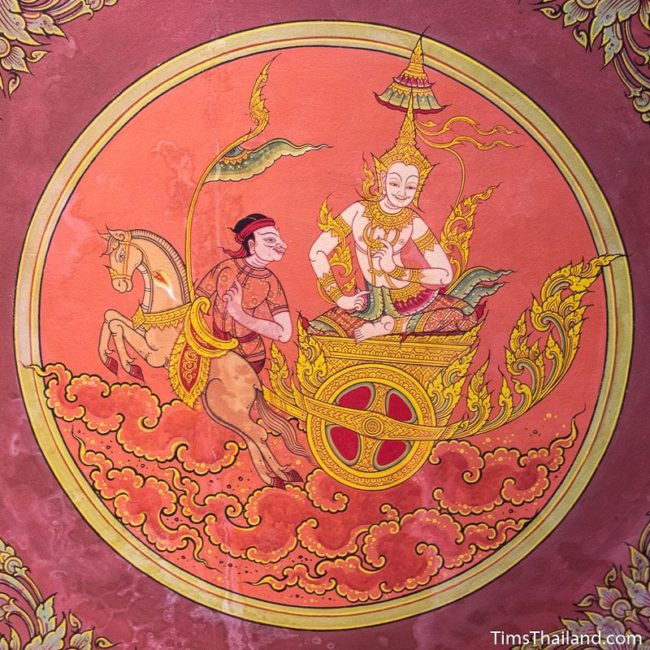
5 – Mahosot Chadok (มโหสถชาดก)
- Standard name: Maha-Ummagga Jataka (#9)
- Perfection of character: wisdom (panna)
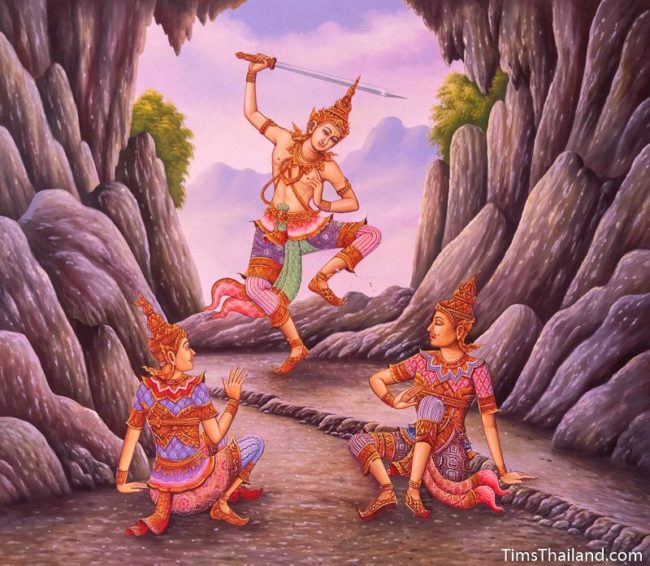
The Bodhisatta was once a king’s advisor named Mahosadha. On the day the Bodhisatta was conceived, King Vedeha dreamt of a great fire in his palace and his four advisors explained this meant a new advisor, wiser than all other men and gods, would soon be born and eventually come serve him. The Bodhisatta was an exceptionally bright and precocious child. By age seven there was nobody wiser, stronger, or more beautiful in the whole kingdom and King Vedeha wanted to hire him. But Senaka, his chief advisor, did not want to lose his status and recommended watching the Bodhisatta for a while to ensure he was really the one predicted in the king’s dream.
A man stayed in the Bodhisatta’s village and reported his activities back to the palace. On multiple occasions the Bodhisatta exposed thieves through clever detective work, such as asking suspected cattle thieves what they fed their cows and then inducing vomiting to see if they were right. He also scared a hawk into dropping meat by stepping on its shadow and rebuked Indra, king of the gods, for making mischief on earth. Despite the boy’s obvious superiority, Senaka urged caution and proposed some challenging tests – using honey and ants to put a string through a tiny hole in a gem, distinguishing a male from a female snake, cooking rice with no water (he used snow), etc. – and he passed them all. Finally, King Vedeha invited the Bodhisatta to the palace where he belittled the four royal advisors and proved his incomparable wisdom one more time by convincing the king that status should not always be based on age. He was hired as the king’s fifth advisor and as he grew up he solved many problems that stumped the other four; and they never lost their animosity toward him. Twice they got the king to order the Bodhisatta’s execution, but both times their devious schemes were exposed.
As an adult, the Bodhisatta took charge of the kingdom’s well-being because King Vedeha was such a fool. He built moats and a rampart around the city, dug new reservoirs, stocked the storehouses with food, and sent spies out to all the other kingdoms. So when King Culani set out to conquer all of India, King Vedeha and the Bodhisatta were prepared and King Culani chose not to attack, satisfied with controlling all the kingdoms but one. The other one hundred kings had chosen to submit to King Culani rather than fight, and King Culani invited them to his palace for a feast where they would be killed by poisoned liquor, then replaced by loyalists. The Bodhisatta sent men to save the subordinate kings’ lives by knocking over all the food and drink.
An enraged King Culani sent his armies to attack King Vedeha, but they were defeated. King Culani wanted to force surrender by cutting off water and food, but thanks to the Bodhisatta’s wisdom it became clear a siege would not work. His advisor, Kevatta, proposed tricking the Bodhisatta in a Battle of the Law: whichever advisor bowed to the other first was the loser. Because Kevatta was the elder of the two, and since he was not going to tell the Bodhisatta the rules of the game, Kevatta was confident this would secure a victory for King Culani. But thanks to his spy network the Bodhisatta knew everything and won the battle by throwing a gem at Kevatta’s feet when they first met and when people saw him lean over to pick it up, they thought he was bowing.
Kevatta never forgot his humiliation and a year later proposed luring King Vedeha to his demise by offering him King Culani’s gorgeous daughter, Princess Pancalacandi, for marriage. King Culani, still wanting to rule all of India, agreed. King Vedeha took the advice of his other four advisors over the dire warning from the Bodhisatta who, having sent a spy parrot to King Culani’s palace, knew for certain the marriage was a trap. Knowing that his wise words would not save the foolish King Vedeha, the Bodhisatta went to King Culani’s kingdom as an envoy to prepare for the royal wedding by building a palace for King Vedeha to stay in. This construction project provided cover for digging an enormous tunnel between his palace and King Culani’s.
When construction was complete, King Vedeha eagerly made the long journey and King Culani promised to hold the wedding the next morning. But in reality, he mustered his troops and surrounded King Vedeha, waiting for sunrise to attack. As the troops approached, the Bodhisatta put his plan in action. He sent three hundred men to King Culani’s palace to kidnap his family and hide them away in the tunnel. And after a forceful I-told-you-so to King Vedeha, the Bodhisatta took him to marry Princess Pancalacandi and then sent everybody safely back home.
At sunrise, the Bodhisatta confronted King Culani and told him King Vedeha had already married and departed, and had taken King Culani’s chief queen, son, and mother with him. They would only be released if the Bodhisatta returned safely: anything that happened him would be done to them. King Culani was furious, but calmed down because he knew the Bodhisatta was an honest man, and would return his family. The Bodhisatta walked the king, his subordinate kings, and many soldiers and courtiers through the tunnel and they were all astounded. When they reached the end, the Bodhisatta locked everyone except the king inside and drew his sword. The king was terrified, but the Bodhisatta said he was not going to kill him, he’d only done it to prove his superiority. Then he and the king talked and became good friends.
Not knowing what was going on outside the tunnel, those trapped inside it feared they were going to die, so when the Bodhisatta opened the door, they thanked him for saving their lives. He let the subordinate kings know he done so once before and revealed King Culani and Kevatta’s plan to poison them. King Culani blamed everything on Kevatta and the other kings forgave him. The Bodhisatta returned home and sent King Culani’s family back, and there was no more conflict between the two kingdoms. Years later, when King Vedeha died, the Bodhisatta went to work for King Culani. and he served his new king as faithfully as his old and the citizens respected him just as much.
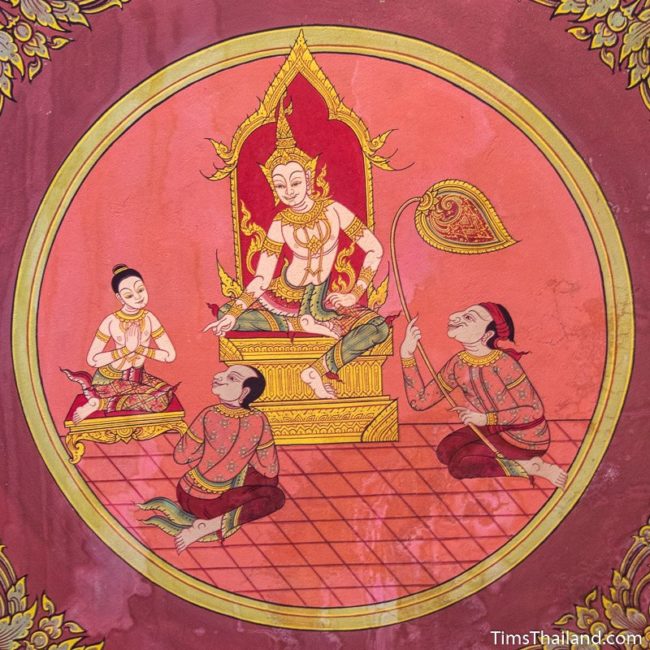
6 – Puritatda Chadok (ภูริทัตชาดก)
- Standard name: Bhuridatta Jataka (#6)
- Perfection of character: virtue (sila)
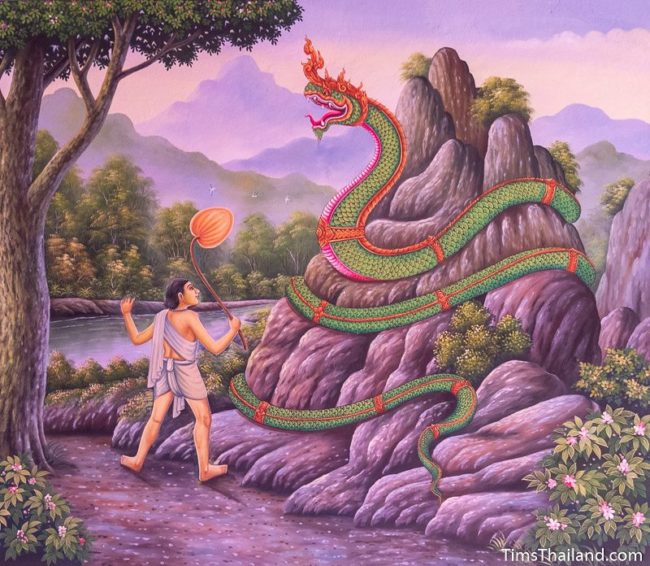
The Bodhisatta was once a naga king named Bhuridatta. The Bodhisatta’s human grandfather, Prince Brahmadatta, had been banished by his paranoid father, the king, who worried Brahmadatta would seize the throne from him. He lived alone in the wilderness waiting for his father to die, at which time he would become king. A widowed naga woman took a human form and visited the realm of men looking for a husband. She came upon the prince’s hut while he was away gathering food and tested him by decorating his bed with flowers. Not a true ascetic at heart, the flowers filled him with joy, so he quit the holy life and they got married. They lived in a palace she magically summoned and had two children, a son named Sagara and a daughter named Samuddaja. As their father was human, so were they. When the king finally died, Brahmadatta returned with his children to rule, but his wife said she could not live among other men and so she returned to the naga realm alone.
One day a turtle scared the children. King Brahmadatta captured it and sentenced it to death, but the turtle tricked the king into throwing it into a whirlpool where it escaped to the naga realm. There the turtle was captured again and this time it avoided execution by claiming to be a messenger from King Brahmadatta come to propose a union between their lands and offer his daughter for marriage. So the naga king sent the turtle and four emissaries to arrange the wedding. King Brahmadatta declared it would be inappropriate for a human king to give a princess to a naga king. Furious at this disrespect, the naga king sieged the city leaving King Brahmadatta no choice but to give away his daughter, Samuddaja. Miserable over losing her, he abdicated and resumed his ascetic life, giving the throne to his son Sagara.
Queen Samuddaja raised four sons, including the Bodhisatta, and when they came of age their father gave them each their own glorious kingdoms. The Bodhisatta wanted to ensure his next life would be in heaven, so he faithfully followed the holy-day vows. To avoid distraction, he did his biweekly fast sitting atop an anthill in the human realm. One morning a hunter caught sight of the Bodhisatta. Worried this man would betray him, the Bodhisatta invited him to a live a life of luxury in the naga realm where he could not harm him. But after a year the hunter missed his family and returned home. So as not to risk upsetting the Bodhisatta, the hunter lied that he was leaving to become an ascetic, and when the Bodhisatta offered him a magic jewel that granted wishes he refused it because as an ascetic he should have no desires.
Soon after, a group of young naga who served the Bodhisatta lost the magic jewel while visiting the human realm and a snake-charmer found it. While in the forest, the hunter saw the snake-charmer with the jewel and wanted it desperately. Not knowing the jewel had magic powers, the snake-charmer said he would give it to anyone who could help him capture a naga and the eager hunter took him to the Bodhisatta’s anthill. The excited snake-charmer threw the jewel to the hunter, but it slipped through his hands and disappeared into the ground down to the naga world, so the hunter went home in sorrow. The snake-charmer recited his serpent-spell and beat the Bodhisatta into submission; he suffered great pain, but was so pure he felt no anger.
The snake-charmer stuffed the Bodhisatta into a basket and took him village to village doing shows. He ordered the Bodhisatta to change his size, shape, and color; make himself invisible; spit out water and smoke; and dance. Hoping he would be released after the snake-charmer made a lot of money, the Bodhisatta did everything he was asked. Meanwhile, the Bodhisatta’s family searched for him across heaven and earth. And just as he was about to do a show for King Sagara, the Bodhisatta’s elder brother arrived and rescued him. The snake-charmer was turned into a leper and another of the Bodhisatta’s brothers tortured the hunter, but he was later forgiven by the Bodhisatta. After he recovered, the Bodhisatta and his brothers reunited their mother with her father and brother on earth. And when he died, the Bodhisatta earned the rebirth in heaven he had worked so hard for.
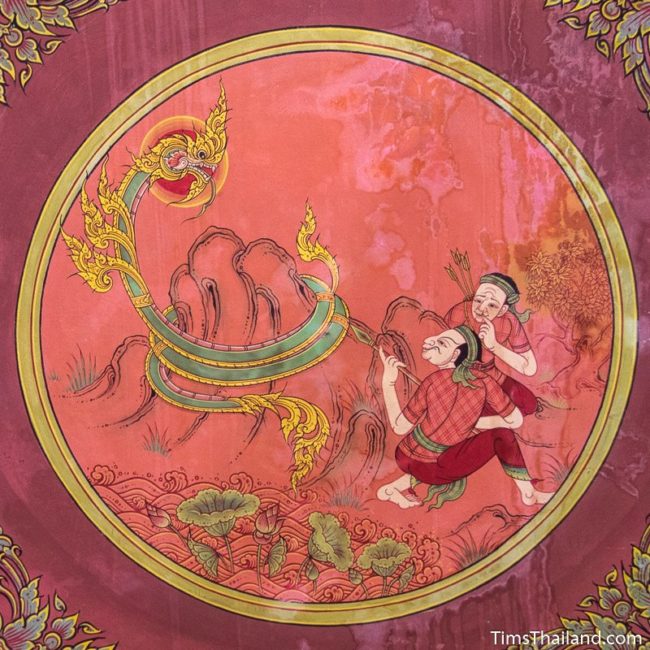
7 – Jantaguman Chadok (จันทกุมารชาดก)
- Standard name: Khandahala Jataka (#5)
- Perfection of character: patience (khanti)
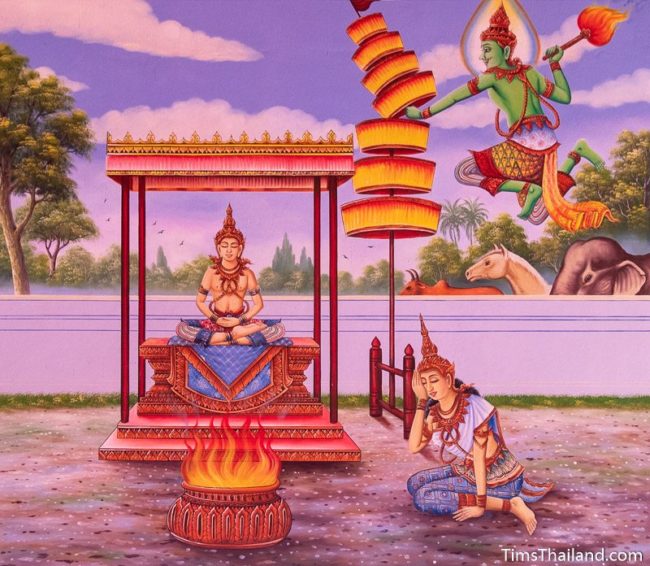
The Bodhisatta was once a crown prince named Canda. The king’s chaplain was thoroughly corrupt and when serving as judge he took bribes and cheated people. One of his victims fell at the Bodhisatta’s feet and begged him to tell the king the truth about the chaplain. Out of pity, he took the man back to court and judged the case himself, finding in his favor and returning his property. The people applauded the Bodhisatta and the king appointed him as judge. Cut off from his illicit income, the chaplain decided to kill him.
The king was not religious, but after dreaming about heaven he asked his chaplain how to get there. Seizing the opportunity, the chaplain told the king he must perform the fourfold sacrifice (killing four of each kind of living creature; from humans to bulls to birds) including four of his family. The king told him to arrange it promptly. The Bodhisatta knew the chaplain was seeking revenge against him and the fourfold sacrifice was just a ruse to hide this fact from the king, but he could not stop him. Citizens protested in the streets and the king’s parents pleaded in tears for him to stop this monstrous act, but the king would not listen. His heart was broken about killing his family, but he trusted his chaplain and would do whatever it took to get into heaven.
The Bodhisatta was taken to the chopping block first. As the chaplain stood beside him with sword in hand the chief queen prayed for divine intervention. Indra, king of the gods, heard her plea and came down to earth. He threatened and frightened the king and stopped the sacrifice. A mob stoned the chaplain to death, banished the king, and put the Bodhisatta on the throne.
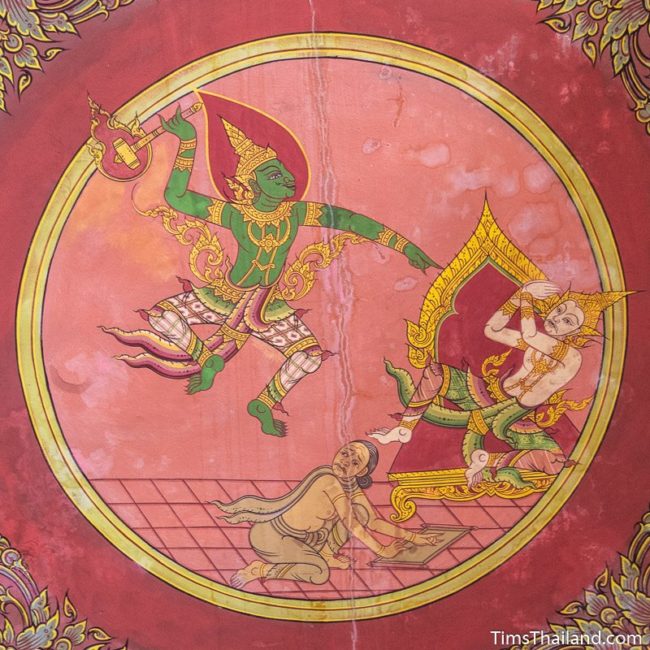
8 – Narata Chadok (นารทชาดก)
- Standard name: Mahanaradakassapa Jataka (#7)
- Perfection of character: equanimity (upekkha)
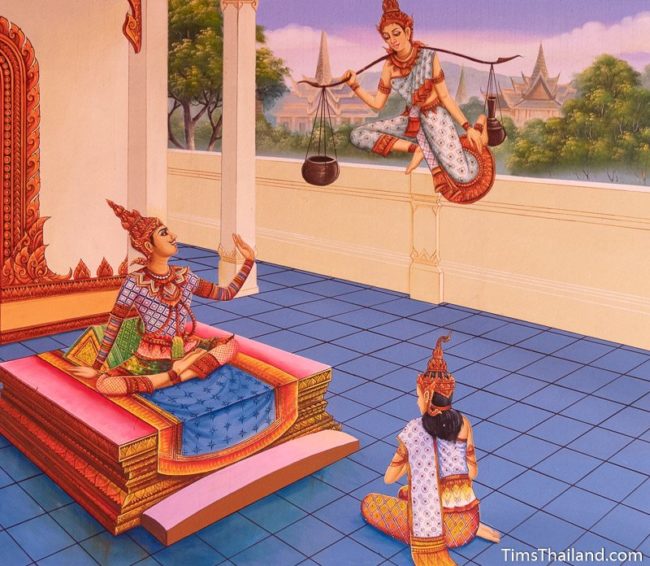
The Bodhisatta was once a god named Narada. The powerful, righteous King Angati met a naked ascetic who preached a false doctrine embracing greed. There is no heaven or hell, no sin, and those who help others are feeble fools, the naked ascetic proclaimed. King Angati embraced this message and declared that from then on out he would dedicate himself to enjoying life to its fullest. At the next holy day his beloved daughter, Princess Ruja, full of great merit, came to collect the money she would give for alms, as she always did; but to her horror her father refused to give her any. He would deny her no luxury, King Angati said, but following holy-day vows was a waste of time and money: all her worry about virtue was pointless and he would not support it.
The angry princess rebuked her father for following the advice of fools and logically pointed out that if the naked ascetic was correct about not earning merit for righteous living, then he was an idiot for following a difficult, austere life because it would bring him no benefit. She tried to explain to him that like a ship carrying too much cargo does not sink immediately but goes down slowly, a person accumulating sin will not see the consequences right away; but for sure they will come. But King Angati would not listen to his daughter’s divine wisdom and remained, unknowingly, on his path to hell. So Princess Ruja bowed to all ten directions and called out for some deity to come save her father. The Bodhisatta heard her prayers and came to earth to break the king away from his false doctrine.
The Bodhisatta assured the king that karma was real and people determined their destinies. The king mocked this belief by asking for a loan of five hundred coins, promising to repay him a thousand after he died. The Bodhisatta drew shouts of delight when he replied that he could not collect a debt in hell, where the king was going. He followed this up with a description of hell’s endless torments such as having your body torn apart by flocks of ravens, having to pull a chariot across burning ground, and climbing trees with swords for leaves. Fear of hell finally made the king rethink his decision and he let the Bodhisatta teach him the path of purity.
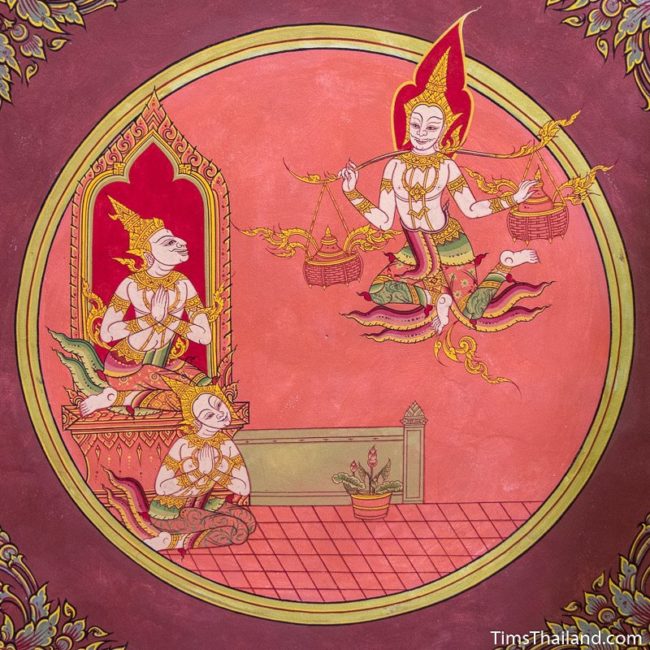
9 – Witoonra Chadok (วิทูรชาดก)
- Standard name: Vidhurapandita Jataka (#8)
- Perfection of character: truthfulness (sacca)
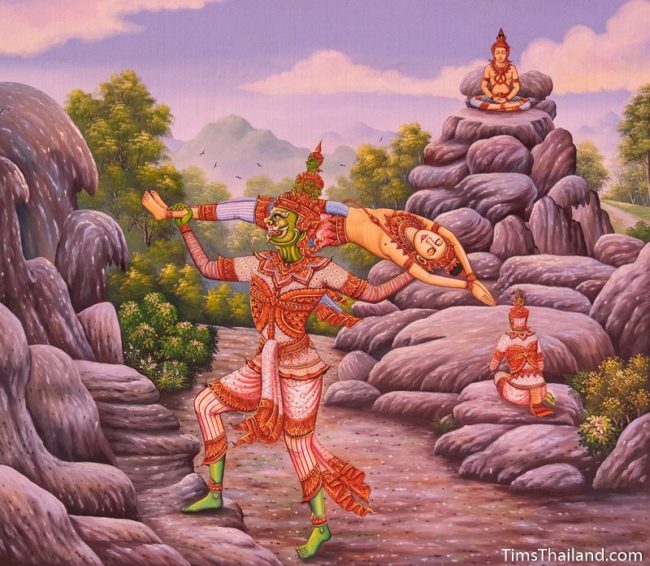
The Bodhisatta was once a king’s advisor named Vidhurapandita. One day four great kings – Indra, king of the gods; a naga king; a garuda king; and King Dhananjaya, the Bodhisatta’s king – sat down to chat. They got to discussing which of them was the most virtuous and each felt they were superior to the others. So they asked the Bodhisatta to decide and he answered that all four were equal. This pleased the kings immensely and they showered him with gifts.
When the naga king told his queen about the Bodhisatta’s wisdom and eloquence, she decided she must meet him. She told her husband that if she did not obtain the Bodhisatta’s heart, she would die. The distressed naga king wanted to satisfy his queen, but he didn’t know anyone who would do such a wicked thing. Then he found a solution – he asked his beautiful daughter to seek a husband who would get the Bodhisatta’s heart; and in order to save her mother’s life, she agreed. She sang out her availability and Punnaka, a nephew of the goblin king Vessavana, fell in love instantly and agreed to kill the Bodhisatta.
There was no way anyone could just seize the Bodhisatta, but King Dhananjaya was a renown gambler and Punnaka would win him in a dice game. He bet his flying horse and a magical gem against everything the king owned other than his body and his sovereignty. And through his special powers, Punnaka won the game and claimed his prize. They flew off to a mountain peak where Punnaka grabbed the Bodhisatta and was about to throw him over a cliff when he decided to ask Punnaka why he wanted him dead. Hearing about the naga queen’s request and the princess’s promise, the Bodhisatta realized this was all a misunderstanding: the heart of sages is their wisdom. There being no reason for a naga queen to want him dead, she must have asked someone to bring him there to preach and they misinterpreted her words. At the Bodhisatta’s request, Punnaka took him to the naga realm alive. He was correct about the misunderstanding and the naga king and queen were greatly pleased to hear him preach.
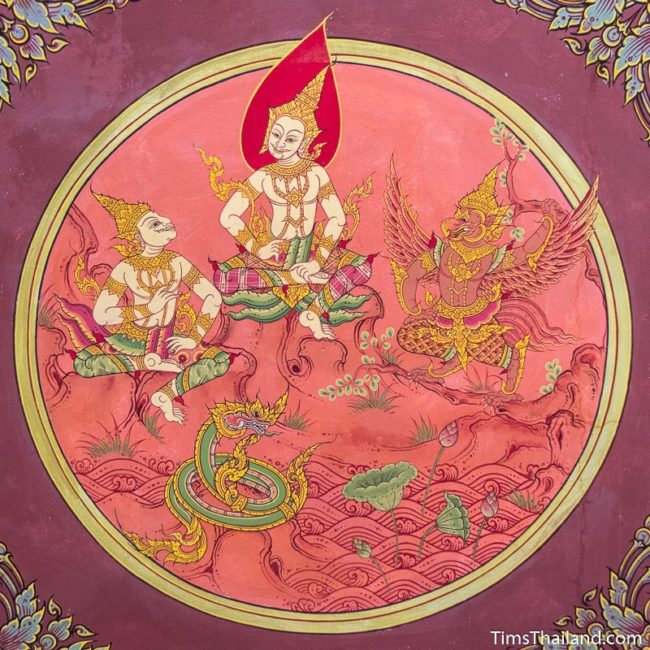
10 – Wetsandon Chadok (เวสสันดรชาดก)
- Standard name: Vessantara Jataka (#10)
- Perfection of character: generosity (dana)
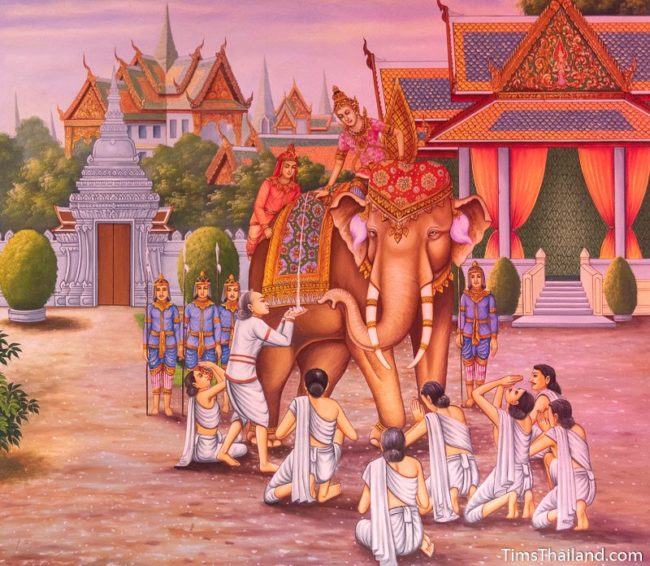
The Bodhisatta was once a prince named Vessantara. He was free from impurity and as generous as anyone could be. Just moments after he was born he asked his mother, Queen Phusati, to give him money so he could donate it, and his incomparable generosity continued throughout his childhood. Eventually King Sanjaya abdicated in favor of his son, and as king, Vessantara continued to offer charity to anyone who asked for it. When a neighboring kingdom suffered drought and famine he gave them the city’s auspicious white elephant, which ensured rain wherever it went. The Bodhisatta’s loyal subjects were horrified by this and feared the kingdom would be ruined without its elephant. They went to Sanjaya and demanded his son be stripped of his crown and banished to Vankagiri mountain (Thai versions of the story usually call it Khao Wongkot, “Labyrinth Mountain”) deep in the Himalayan wilderness. They were so angry and fearful that Sanjaya had no choice but to accept their demand and return to the throne. He gave his son one final day in the city before having to leave. He spent it giving away elephants, horses, chariots, cows, slaves, and many other things to everyone who came, from brahmins to untouchables.
He told his wife Maddi to stay behind, but she insisted she would rather die that leave him, so early in the morning they and their two children, a son, Jali, and a daughter, Kanhajina, rode out of town. Before they got very far the Bodhisatta gave away their horses and carriage, so they had to walk. Everyone along the way pitied them, including the trees, which bowed their branches so they could easily pick fruits. They made some stops along the way for supplies, rest, and directions and through divine intervention made it to their Himalayan home in two days rather than two weeks. They put on ascetic clothes, moved into leaf huts, and started their new life in the forest.
In another kingdom lived Jujaka, a decrepit old brahmin with a very young wife given to him when her parents could not repay a debt. She cared for him so well, she made other wives resentful and they mocked her. To avoid having to endure their vicious words, she demanded Jujaka get some domestic help. He couldn’t afford to hire workers or buy slaves, so he went to ask the Bodhisatta for his children. Many people tried to prevent him reaching the Bodhisatta’s home, including a forester whose dogs chased him up a tree, but through various well-told lies and the assistance of the gods, who wanted to support the Bodhisatta’s generosity, Jujaka found the right path.
Jujaka waited until Maddi was out gathering food in the forest to approach the Bodhisatta who, with a mixture of sorrow and joy (he felt guilty for what he did to Jali and Kanhajina, but nothing made him happier than giving things away) sent his children off to be slaves. After they were gone he meditated on nonattachment and his sadness went away. The gods knew Maddi would chase after her children when she learned what her husband had done, so three of them took the forms of a lion, tiger, and leopard to block her path home until after it was dark. Fearing her children were dead, Maddi was heartbroken and passed out. The Bodhisatta splashed water in her face to revive her and admitted what he had done, assuring her that someday they would see their children again. Knowing that generosity brought her husband bliss made her sorrow turn to joy. Indra knew that eventually someone would come demand Maddi, leaving the Bodhisatta alone and helpless, so he took human form and did it himself. The Bodhisatta was pleased to give her away, and Maddi was pleased to go, because now he had finally given away everything of value and achieved supreme perfection of generosity. Right after this, Indra revealed himself, returned Maddi, and granted the Bodhisatta eight wishes.
While Jujaka walked home, deities cared for Jali and Kanhajina. Each night for two weeks Jujaka tied them up on the ground while he slept safely up in trees, away from wild beasts. When he fell asleep, two gods taking the form of their parents untied the children and let them sleep on a celestial couch. During the day, other gods guided Jujaka along the wrong route so he ended up at the Bodhisatta’s home instead of his own. King Sanjaya was overjoyed at seeing his grandchildren and bought their freedom. Jujaka moved into a palace and ate so many fine meats he died.
A remorseful King Sanjaya decided banishing the Bodhisatta had been a mistake and led an entourage to bring his family back. The auspicious elephant had since been returned, so the kingdom’s citizens had forgiven the Bodhisatta and by popular demand he was made king again. They greeted his return with song and dance and the Bodhisatta gave charity through the rest of his days.
